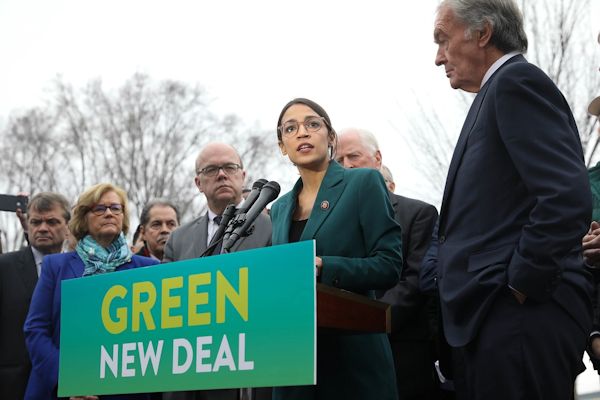SEJournal Online is the digital news magazine of the Society of Environmental Journalists. Learn more about SEJournal Online, including submission, subscription and advertising information.
 |
| Reps. Alexandria Ocasio-Cortez (center) and Ed Markey (at right) at a press conference in Washington, D.C., on Feb. 7, introducing a sweeping Green New Deal proposal. Photo: Courtesy Senate Democrats, Wikimedia Commons. Click to enlarge. |
TipSheet: Is the Green New Deal for Real?
The Green New Deal program announced on Feb. 7 by Rep. Alexandria Ocasio-Cortez (D-N.Y.) and Sen. Ed Markey (D-Mass.) may be just a broad outline, lacking much of the specificity and detail of any actual legislation that many committees in Congress would have to labor long and hard to produce and pass.
But you can still expect it to be news for a while. And if you are writing about climate (which inevitably involves environmental politics), it is good to know what it’s about.
First, what the Green New Deal proposal is not. It’s not a bill that creates law. Rather, it came in the form of a resolution (text here), and as such it expresses the sense or intention of Congress. It is, in effect, non-binding.
So the Green New Deal resolution may be like a mirage in the desert — at least, if that desert is years of legislative and regulatory inaction to control climate. Or it may be a first draft of the Democratic party’s national platform for 2020.
But either way, the Green New Deal’s promise — and its vagueness — may offer both inspiration and illusion.
What is the Green New Deal?
From an environmental journalist’s perspective, the Green New Deal amounts to an agenda or check-list of things to watch for and cover.
As envisioned by its most prominent advocates,
the Green New Deal is a far-reaching proposal
for the United States to reach a
zero-carbon economy within ten years.
As envisioned by its most prominent advocates like Ocasio-Cortez, the Green New Deal is a far-reaching proposal for the United States to reach a zero-carbon economy within ten years.
At its core is an effort to convert the nation to “clean, renewable and zero-emission energy sources” … and in the process to create many new green jobs. It might include retrofitting every building in the United States for maximum energy efficiency.
But its sponsors see it as a plan for much more: a progressive wish-list that includes universal health care, free college and an end to homelessness, as well as rights for the indigenous, for example. What’s new about it is its radically increased scope and sense of urgency. [Editor’s Note: See our Green New Deal backgrounder for more, plus get the latest developments in EJ Today by searching "Green New Deal."]
Why does it matter?
A U.N. science report in October 2018 warned of catastrophic consequences if the world did not make urgent and unprecedented emissions cuts within 12 years. Global warming beyond 1.5ºC will bring drought, floods, extreme heat, famine and poverty for hundreds of millions of people, the Intergovernmental Panel on Climate Change said. A report by U.S. federal science agencies said in November 2018 that huge economic harm from climate was imminent in virtually every region of the United States.
Despite the new urgency, Trump administration officials continue doubting established science that humans are changing climate, and pressing on with policies hamstringing the Paris Agreement on climate and repealing Obama-era regulatory controls like the Clean Power Plan.
Story ideas
- What’s your member of Congress’ position on the Green New Deal? Is he or she a cosponsor? For it? Against it? Waffling?
- How much green energy employment does your area currently host? How much could it potentially host?
- What measures might improve climate resiliency in your area?
- Does your area have a favorite son or daughter in the 2020 Democratic presidential primary sweepstakes? What is his or her position on the Green New Deal?
- What grassroots groups in your area are engaged in the Green New Deal? What issues are engaging them?
- Have Green New Deal activists visited or conducted sit-ins at the office of your local member of Congress?
Reporting resources
- Sunrise Movement
- House Select Committee on the Climate Crisis — No current link. Wait until they get organized.
- Rep. Alexandria Ocasio-Cortez
- Sen. Ed Markey
- House Energy and Commerce Committee
- House Natural Resources Committee
* From the weekly news magazine SEJournal Online, Vol. 4, No. 7. Content from each new issue of SEJournal Online is available to the public via the SEJournal Online main page. Subscribe to the e-newsletter here. And see past issues of the SEJournal archived here.













 Advertisement
Advertisement 



